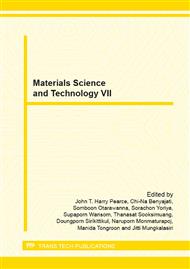p.182
p.188
p.193
p.197
p.211
p.219
p.225
p.230
p.236
Experimental Investigation of De-Oiling Hydrocyclone
Abstract:
Even though the hydrocyclone can be well used for de-oiling, the major problem with normal hydrocyclones is that they discharge relatively large amounts of oil with the water through the underflow. Therefore, the suitable hydrocyclone proportion and optimum hydrocyclone operating conditions should be investigated carefully to achieve better separation efficiency. In this research, a 35 mm hydrocyclone was studied for separating 25% of oil and 75% of water. The objective of the present manuscript was to investigate the important parameter and operating conditions that affected the oil recovery in the overflow. The investigated factors were inlet diameter, inlet velocity and flow ratio. From the experimental results obtained it could be concluded that 1) a decrease in inlet diameter led to an increase in the oil recovery in the overflow; 2) an increase in inlet velocity led to an increase in the oil recovery in overflow. In fact, the inlet velocity that provided the best oil recovery in this research was 8 m/s; 3) an increase in the flow ratio led to an increase in the oil recovery in the overflow.
Info:
Periodical:
Pages:
230-235
Citation:
Online since:
March 2013
Keywords:
Price:
Сopyright:
© 2013 Trans Tech Publications Ltd. All Rights Reserved
Share:
Citation:


